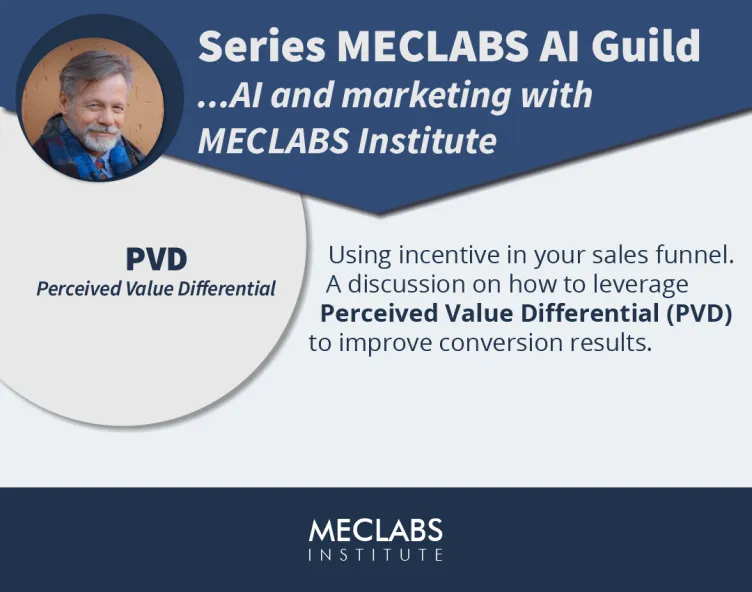I am in an online MECLABS AI Guild session. Daniel Burstein is coaching (challenging) one of the Guild members.
"But I think the challenge is how many of those are there out there, right?"
In the MECLABS AI Guild, we craft sales funnels. We apply MECLABS thinking tools to our funnel thinking. The second thinking tool is Customer-First Objective. We apply the TO help…, BY offering… In exchange FOR… heuristic. In exchange FOR will often contain an incentive. This article looks at how effective a free offer is as an incentive. Is a free offer actually free? More to the point, can it also be a deterrent? Read on.

Where are we in the sales funnel process?
We are in the early planning phases of building out our sales funnels. Focusing on teaching tool one and two. Initial Customer Profile and Customer First Objective.
Daniel is coaching the second tool, Customer First Objective. With this tool, we apply the MECLABS TO, BY, FOR three line heuristic to our sales funnel thinking. This helps structure a customer-centric objective.
- TO help [our target customer];
- BY offering [what we are going to give];
- In exchange FOR [what we want].
We find incentive in the BY offering section of the heuristic. In this case, the incentive was a free two-hour Google Ads training course.
Daniel’s challenge;
But I think the challenge is how many of those are there out there, right?
There are many, many, many who offer free Google Ads training. Some big players, including Google. The question we raise in Daniel's challenge is;
How effective is the incentive of a free two-hour Google Ads training course?
Daniel is talking to the perceived value of the incentive. He then introduced the MECLABS Perceived Value Differential heuristic. This heuristic is one of the MECLABS patented methodologies.
We calculate the Perceived Value Differential (PVD) with the following. The Perceived Value (Vp) of the offer less the Net Delivered Cost (C$n) of the offer. The higher the PVD, the greater the performance of the incentive. Performance is the ability of the incentive to influence a conversion.
On the surface, this heuristic sounds logical and simple. I applied it to my own process. I soon realised I did not fully understand how the nuances of the heuristic worked.
Flint McGlaughlin YouTube @FlintNotes
My next step, a search on Flint McGlaughlin's YouTube channel . To my relief, I discovered this video class on the subject. Flint goes into great depth on how PVD works and how we use it to increase performance. The depth covered in the video is beyond the scope of this article. It will be the subject of a next.
I have made a mind map on the class.
After watching Flint's class , I came back to this use-case. The incentive is a free two-hour Google Ads training. The net delivered cost should be low. For sake of illustration, say R10. The training will be an on-demand video recording.
What about the perceived value? There are countless offers of Google Ads training - for free. So the perceived monetary value will be zero. If this is the case, the PVD will be a negative number.
PVD = Vp - C$n © MECLABS
R0 - R10 = -R10
This implies resistance for the prospect.
The net delivered cost revisited
Let us revisit cost.
Negative emotional factors are (I think) not attributed to the net delivered cost. Factors such as friction, stress, trust and anxiety. While not part of C$n, I say they are applicable in our discussion here.
There will be a potential trust issue related to an unknown source for the training. Concerns about spam and having to deal with potential unwelcome sales material. Concerns about training quality. The opportunity cost of time.
It is then possible that the free 2-hour Google Ads course is working against a conversion. It is achieving the polar opposite of its intended outcome.
To make sure my conclusion was accurate and valid, I decided to check with an authority. I thought to raise the question in the AI Guild. A thought then crossed my mind. Why not check my conclusion using the MECLABS AI Tool ? After all, the MECLABS methodology is baked into the tool. The outcome was both interesting and pleasing.
AI and the final word
PROMPT:
OUTPUT:
PROMPT:
OUTPUT:
Related Articles
The following articles may be of interest.
References
This article was written with the help of these excellent resources.
Add new comment